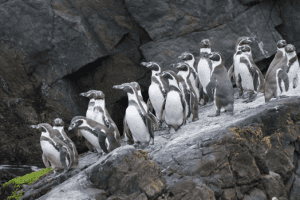TAG: GS 3: ECOLOGY AND ENVIRONMENT
THE CONTEXT: Humboldt penguins (Spheniscus humboldti), native to the Pacific coasts of Chile and Peru, are facing a severe decline in population, pushing them towards the brink of extinction.
EXPLANATION:
- Recent surveys and studies highlight the critical situation of these vulnerable birds, emphasizing the urgent need for conservation efforts.
Population Decline
- A dramatic decrease in Humboldt penguin populations has been observed along the central coast of Chile.
- Scientists conducted surveys on two islands off the coast and found a drastic reduction in breeding pairs.
- In the previous year, there were 842 breeding pairs or active nests, but this year, only one breeding pair was detected.
- Paulina Arce, a veterinarian specializing in penguins, noted that penguin populations in all surveyed islands either decreased or remained the same, indicating a widespread issue.
Primary Threats to Survival
- Several factors contribute to the decline of Humboldt penguin populations, each exacerbating the other:
- Marine Pollution: Pollution in the ocean, including plastic waste and oil spills, significantly impacts penguin health and habitat.
- Lack of Pet Supervision: Domestic animals, especially dogs, pose a threat to penguin nests, causing disturbances and potential predation.
- Nesting Site Disturbance: Human activities, such as tourism and coastal development, disturb penguin nesting sites, leading to decreased reproductive success.
Impact of Avian Flu and El Nino
- The combination of avian flu and the El Nino weather phenomenon has created a dire situation for Humboldt penguins.
- The avian flu has directly caused deaths among the penguin population.
- El Nino has shifted food sources towards the southern zone, drastically reducing reproduction rates in northern Chile.
- This “perfect storm” of conditions has driven reproduction to nearly zero levels and resulted in significant penguin mortality.
Conservation Challenges
- The rapid decline in Humboldt penguin populations poses several challenges for conservationists:
- Immediate Action Needed: Urgent measures are required to address marine pollution, enforce pet supervision, and protect nesting sites.
- Disease Management: Strategies to manage and mitigate the spread of avian flu are crucial to preventing further outbreaks.
- Climate Adaptation: Understanding and mitigating the impacts of climate phenomena like El Nino is essential for the survival of these penguins.
Future Outlook
- Without immediate and comprehensive conservation efforts, the Humboldt penguin faces a bleak future.
- The sharp decline in breeding pairs from 842 to just one in a single year is a stark indicator of the species’ vulnerability.
- Ensuring the survival of Humboldt penguins will require coordinated efforts from governments, conservation organizations, and local communities.
Humboldt penguins
- The Humboldt penguin (Spheniscus humboldti) is a medium-sized penguin.
- It resides in South America, its range mainly contains most of coastal Peru.
- Its nearest relatives are the African penguin, the Magellanic penguin and the Galápagos penguin.
- These flightless birds weigh up to 5 kg (11 pounds) and measure up to 70 cm (2 feet 3 inches) tall when fully grown.
- They play a crucial role in their ecosystem, influencing marine biodiversity and serving as indicators of ocean health.
- The Humboldt penguin and the cold water current it swims in both are named after the explorer Alexander von Humboldt.
- The species is listed as vulnerable by the IUCN with no population recovery plan in place.
- The current population is composed of 32,000 mature individuals and is going down.
- It is a migrant species.

Humboldt Penguin
SOURCE: https://www.nbcnews.com/news/latino/penguins-extinction-chile-humboldt-rcna156585
Spread the Word
